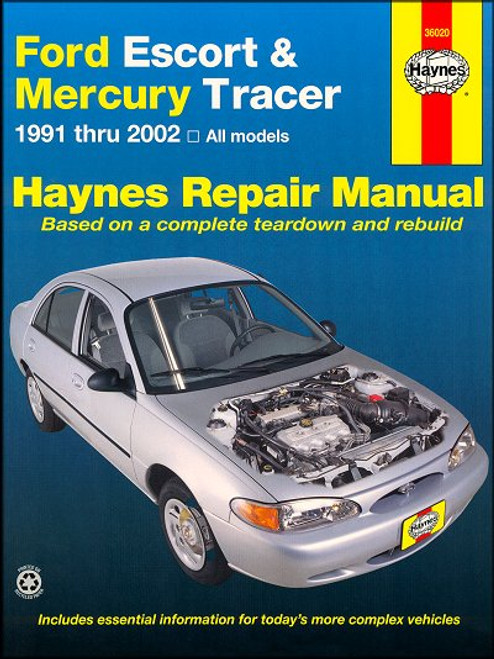This DIY service, maintenance and repair manual by Haynes, covers 1996-2007 Ford Taurus and Mercury Sable passenger cars.
Note: The manual DOES NOT include information specific to SHO or variable fuel / E85 models.
Book Excerpt: 1996-2007 Ford Taurus, Mercury Sable Repair Manual GENERAL ENGINE OVERHAUL PROCEDURES
This part of Chapter 2 contains the general overhaul procedures for the cylinder heads and internal components. The information ranges from advice about preparation for an overhaul and the purchase of replacement parts to detailed, step-by-step procedures for removal, inspection and installation of internal engine components. The following Sections are based on the assumption that the engine is removed from the vehicle. For information on in-vehicle engine repair, as well as removal and installation of external components, see Parts A and B of this Chapter and Section 7 of this Part. The specifications in this Part are only those necessary for the inspection and overhaul procedures which follow. Refer to Parts A and B for additional specifications. It?s not always easy to determine when, or if, an engine should be overhauled because a number of factors must be considered. High mileage does not necessarily indicate that an overhaul is needed, and low mileage does not preclude the need for an overhaul. Frequency of servicing is probably the most important consideration. An engine that has had regular and frequent oil and filter changes, as well as other required maintenance, should give thousands of miles of reliable service. Conversely, a neglected engine may require an overhaul very early in its life. Excessive oil consumption indicates that piston rings or valve guides need attention. Make sure that oil leaks are not responsible before deciding that the rings or guides are bad, however. Test the cylinder compression (Section 3) or have a leakdown test performed by an experienced tune-up technician to determine the work required. If the engine is making obvious knocking or rumbling noises, the connecting rod or main bearings are probably at fault. To accurately test oil pressure, see Section 2. If the pressure is extremely low, the oil pump or crankshaft bearings are probably worn out. Loss of power, rough running, excessive valve train noise and high fuel consumption may also point to the need for an overhaul, especially if they are all present at the same time. If a complete tune-up does not remedy the situation, major mechanical work is the only solution.
BRAKES
GENERAL INFORMATION All station wagons have disc-type front and rear brakes. Sedans with standard brakes have front disc brakes and rear drum brakes, while those with the optional Anti-lock Brake System (ABS) have four-wheel disc brakes. All brake systems are hydraulically operated and vacuum assisted. Front and rear disc brakes are a single piston, floating caliper design. Rear drum brakes are a leading-trailing shoe design with a single pivot and dual-servo wheel cylinder. Disc brakes automatically compensate for pad wear during use. The rear drum brakes have an automatic adjustment mechanism to compensate for wear. The front brake pads on front-wheel-drive (FWD) vehicles wear faster than on a comparable rear-wheel-drive (RWD) vehicle. Therefore, FWD brake pads should be inspected frequently to prevent disc or caliper damage due to worn brake pads. All models have a cable-actuated parking brake that operates the rear brakes. The hydraulic system uses a dual master cylinder and diagonally split hydraulic circuits. In case of brake line or seal failure, half of the brake system will still operate. Standard brake systems have a pressure control valve to reduce pressure to the rear brakes to limit rear wheel lockup during hard braking. The optional ABS electronically regulates hydraulic pressure to the wheels to prevent wheel lockup loss of control under hard braking. ABS is a sensitive and complex system, and servicing electronic or hydraulic components requires tools, equipment and expertise beyond that of most home mechanics. Therefore, ABS repairs are not covered in this book.
Subject: 1996, 1997, 1998, 1999, 2000, 2001, 2002, 2003, 2004, 2005, 2006, 2007 Ford Taurus, Mercury Sable service, maintenance, and repair instructions. ISBN-10: 1620921448 | ISBN-13: 9781620921449 | Haynes 36075
TABLE of CONTENTS:
Introductory pages
About this manual | Introduction to the Taurus, Sable | Vehicle identification numbers | Buying parts | Maintenance techniques, tools and working facilities | Jacking and towing | Booster battery (jump) starting | Automotive chemicals and lubricants | Conversion factors | Fraction/decimal/millimeter equivalents | Safety first! | Troubleshooting
About this manual | Introduction to the Taurus, Sable | Vehicle identification numbers | Buying parts | Maintenance techniques, tools and working facilities | Jacking and towing | Booster battery (jump) starting | Automotive chemicals and lubricants | Conversion factors | Fraction/decimal/millimeter equivalents | Safety first! | Troubleshooting
- Tune-up and routine maintenance
- Overhead valve (OHV) engine
- Overhead camshaft (OHC) engine
- General engine overhaul procedures
- Cooling heating and air conditioning systems
- Fuel and exhaust systems
- Engine electrical systems
- Emissions and engine control systems
- Manual transaxle
- Automatic transaxle
- Driveaxles
- Brakes
- Suspension and steering systems
- Body
- Chassis electrical system
- Wiring diagrams










